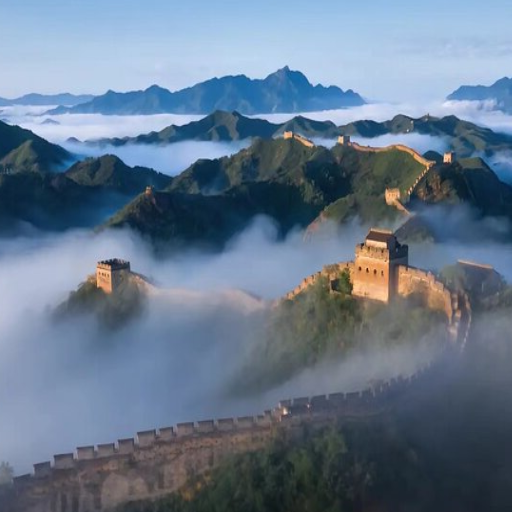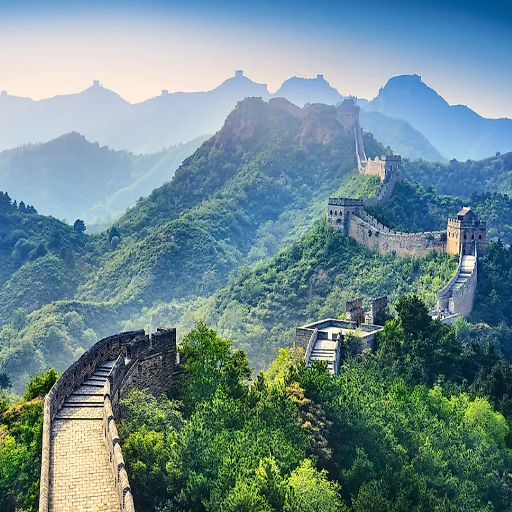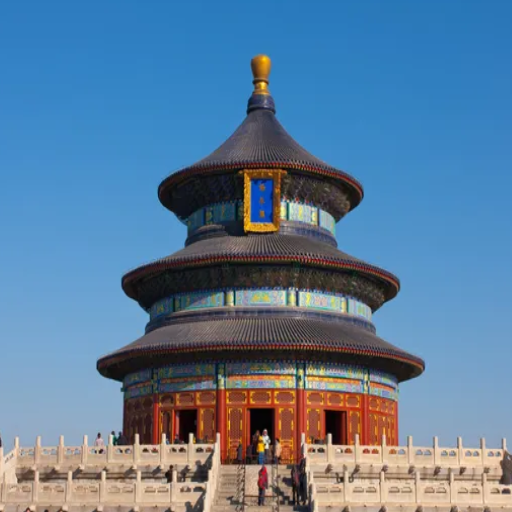Modern achievements meet the ancient history of Beijing in one of the most modern cities in the world. This city’s rich political, cultural, and historical environment and modern development make it ideal for tourists. Through contemporary attractions, hidden gems, and world-renowned sites like The Great Wall and Forbidden City, Beijing hosts its visitors on a mind-blowing trip through history. In this guide, you will find the best 15 places to visit in 2025, showcasing the city’s unique charm and captivating transformation throughout the years. If you are a first-time visitor or a returning traveler, this guide will ensure a lifetime experience.
What are the Top Beijing Attractions?

Exploring the Great Wall of China
The Great Wall of China is a massive symbol of ancient architecture that marks an intrusion and wonder of China. It is located in Beijing and covers a mind-boggling 13,000 miles. The wall was built for crown protection from assault and amber aggressions. Tourists have the flexibility to visit a variety of the most photogenic portions, which include the best working areas like Jinshanling, Badaling, and Mutianyu. Each part presents an extensive array of adventures.
Badaling: This is the most visited and easily recognized cable car. It is well preserved and has easily accessible steps, making it suitable for beginners.
Mutianyu: More tempered crowds, famous for scenic surroundings. It is more child-friendly because of the fun toboggan ride I include.
Jinshanling: This portion is wonderfully suited for walks and gives experience with reconstructions. Jinshanling bears the most resemblance to what the wall once looked like without replastered interference.
Climbing all sections of this Great Wall and Mutianyu will not be as exhausting in the spring and autumn, for they will allow for much better enjoyment. Exploring the Great Wall requires comfortable stout shoes, sunscreen, and a lot of water to remain safe and active.
Unveiling the Forbidden City
Beijing’s beating heart gives a quarter to the famed Forbidden City, a majestic architectural marvel that functioned as an imperial palace for 500 years. Within its 72-hectare territory are around 980 preserved buildings containing 8700 rooms. Built-in 1420 during the Ming Dynasty, its evenness, symmetry, and layout demonstrate the ancient Chinese values of architecture, which emphasized balance, harmony, and more.
A Grand Metre Measuring: Like a sprawling castle, the City’s dimensions have been measured to cover over 961 meters in length and 753 meters in width. In addition, it is encircled by a wall 10 meters high and a moat 52 meters wide.
Durable and Grandeurous: The palace was built using golden bricks and wooden beams, which further ensured its structural strength and durability and enhanced its awe-inspiring beauty.
Oligarchical system: The city is divided into two segments—the Inner Court, home to the family’s Imperial chamber, and the Outer Court, which commands state affairs.
Welcomed Around the World: The beauty of the Forbidden City has been granted its heritage site status by UNESCO as it is now also the peak symbol of traditional Palladian style architecture and abroad for serving as a wonderous piece of Chinese history.
A spring or autumn visit to the Forbidden City offers the most serene experience since it is less bustling at this time. Do not forget that online ticket sales should be purchased days in advance, as tourists frequent the destination. Besides, reserving a whole day to wander its impressive and extensive territory is most advisable.
Strolling through the Summer Palace
The Summer Palace in Beijing is a magnificent piece of landscape gardening in China with rich Chinese heritage; it was also marked as a UNESCO World Heritage site. Covering an area of around 2.9 square kilometers, it features beautiful lakes, gardens, and magnificent pagodas. The Kunming Lake, which makes up approximately three-sixths of the total area, and Longevity Hill, a great vantage point, are the most spectacular parts of the Summer Palace.
The magnificent view of Kunming Lake is best during spring and autumn, when the temperatures are comfortable and strolls on the splendid pathways are possible. You should dedicate at least half a day to fully appreciate the Summer Palace. This will enable you to understand the history and intricate architecture of the Long Corridor, the Marble Boat, and other structures. Waning options and online reservations help alleviate waiting time.
How to Plan Your Beijing Itinerary?

Must-See Tourist Attractions in Beijing
The Forbidden City: Commonly referred to as the Palace Museum, the Forbidden City is an enormous dome of an imperial palace that has housed Chinese emperors for almost five hundred years. It has over a million exquisite rare artifacts and historic treasures, making it an essential site for history and architecture lovers.
The Great Wall (Mutianyu Section): Unlike Badaling, this section is less crowded to be appreciated more. Enjoy the historic watchtowers and the breathtaking view of the mountains surrounding them.
The Summer Palace: A prime example of Chinese landscape design, it stands out among extensive, beautiful gardens, lakes, and pagodas, making it ideal for long walks.
Temple of Heaven: Distinctive circular form and cultural importance make the Temple of Heaven famous as the place where emperors’ annual prayers for good harvests had been offered through sacrifices.
These specially selected spots depict Beijing’s history, culture, and architecture in one city. To make the most of your time, utilize it efficiently.
Choosing the Best Activities in Beijing
While exploring activities for Beijing, remember to pay attention to its historical and cultural importance from an accessibility stance and time management. Here are a few pointers to streamline what will best fit your needs while making the trip worthwhile:
Historical Components: Aim for UNESCO World Heritage Sites such as the Great Wall or the Forbidden City. These sites feature most of China’s imperial history and serve as some of the country’s most famous symbols.
Cultural Components: Partake in events such as local hutongs (traditional alleyways) and Beijing Opera performances to experience the fascinating mix of modern and conventional Beijinese culture.
Geographical Location: Match yourself with the available methods of transport to a given activity to make the most out of your time. Many popular sites, such as the Summer Palace or the Temple of Heaven, can be reached through public transportation or guided tours.
Time Management: If you are time-constrained, focus on primary highlights that are within walking distance of each other. Tiananmen Square and the Forbidden City are neighboring highlights that can easily be visited together.
The previously mentioned pointers will help you achieve a solid balance between meaningful cultural engagement and the historical wonders of Beijing.
Optimal Routes for Sightseeing
To maximize your sightseeing travel in Beijing, I recommend the following routes, considering accessibility, time, and culture.
Travel Order Efficiency: Instead of starting with widely spaced landmarks, begin with clusters of landmarks. For example, a visit to Tiananmen Square and The Forbidden City can be followed by an afternoon at Jingshan Park, which is only a short walk away. This minimizes travel time between locations.
Recommended Methods of Transport: Beijing has a cost-effective subway system that allows for speedy travel.
Time Planning During Sightseeing: Mornings tend to be less busy than the later parts of the day. Try to visit the Great Wall (Mutianyu section) during this time. Estimates suggest spending 2-3 hours at every primary site and remember to plan to transition between venues.
Cultural Integrations: Offer students an alternate live history experience with cultural entertainment. After visiting the Lama Temple, students should try to see the hutongs and sample local food.
This plan will allow an observer to see all the sights while enjoying Beijing’s lovely layout and all the culture and history the city has to offer.
What Makes the Great Wall a Must-Visit?

Exploring Portions of the Great Wall
Mutianyu: Great for families and novice explorers, Mutianyu is famous for its stunning views and restored structures. Positioned 70 km from Beijing’s center, this portion is quieter than most and features a cable car along with 22 watchtowers. The tour can be conveniently started from the Bei Dai He area, only 70 km from Beijing.
Badaling: About 70 km from Beijing, this is the most visited section of the wall; Badaling has scenic spots and is renowned for gentleness. It provides extensive restoration along with mellowed hygiene walking paths, marking it as appropriate for any age. This area features steep historical sites and notable sights like the Great Wall.
Jinshanling: Referred to as the border region, Jinshanling is approximately 130 km northeast of Beijing. This part of the Great Wall is ideal for hikers and photographers who enjoy passionate activities. It offers steep and unrefined sections exhibiting powerful indigenous charm and beauty.
Simatai: Simatai is known as the only area offering night tours. This area combines majestic ancient vertical architecture with sophisticated evening scenery. It is situated 112 km from Beijing, perfect for adventurous people because of its steep angles and amazing prefects.
Jiankou: A majestic section of the wall, Jiankou is a rugged and unrestored part that can only be trekked by proficient hikers. Its beautiful, untouched nature offers a different view of the Great Wall and is located about 43 miles (69 km) from Beijing.
Selecting a part that matches your hobbies, skill set, and travel plans will guarantee that you will deeply appreciate one of the wonders of the world.
The Cultural Importance of Mutianyu
As one of the most famous divisions of the Great Wall, Mutianyu serves as a stunning reminder of the ancient Chinese civilization’s engineering achievements and their enduring cultural heritage. Initially built in the mid-6th century during the Northern Qi dynasty, it was later reinforced by the Ming dynasty in the 14th century to strengthen China’s northern border. With a total length of 7,341 feet (2,238 meters), it has a total of 23 strategically placed watchtowers, illustrating sophisticated military design and advanced transport systems. Its massive granite blocks give the wall a height of approximately 23 feet (7 meters), exemplifying unmatched mastery in construction.
Today, Mutianyu is one of the best-preserved sections of the Wall and is praised for its beauty and intricate design, being a showcase of the Chinese Architectural style. The graceful and vigorous mark amplifies its importance that ancient Chinese civilization has left in history.
Why Is Badaling So Popular Among Tourists
Badaling is a tourist favorite because of its unparalleled ease of access and historical importance. Located 70 kilometers northwest of Beijing, it is the most popular section of the Great Wall, being near a bus terminus, a railway station, and an expressway. This section, built during the Ming Dynasty, has tremendous wall fortifications. The entire wall is about 26 feet (8 meters) high and 16 feet (5 meters) wide, comfortably accommodating soldiers and their gear.
Greatly celebrated for its restoration, Badaling allows patrons to see the Great Wall as it was meant to be viewed. Its towers and battlements are magnificently preserved, showing the Mongol invasions’ strategic defenses. Cable cars and other modern conveniences make the site accessible to all ages and abilities, and combined with the preserved parts of the wall, give travelers an experience unmatched anywhere else in the world.
Which Beijing Attractions Tell the Story of China?

The Imperial Legacy of the Forbidden City
The story of China is abundant and complex. The Forbidden City is arguably the most remarkable structure left from the past as it proves how Chinese architecture once was and is now, along with its imperial heritage. The Forbidden City is separated into numerous sections. The Ming and Qing dynasties were known for their intricate political and cultural systems. Walking through the gates decorated with dreamy sculptures takes one into a living history that undergoes careful, meticulous preservation, including exploring the 980 buildings within.
The Forbidden City spans 180 acres (72 hectares) and has an unexplainable, mysterious beauty that comes from the principles of Feng Shui. These principles emphasize and glorify unison and order. The wooden structures within the city display Chinese skill and mastery of craftsmanship and include golden roof tiles that showcase imperial power. Vitality is showcased through red walls surrounding the city set to ancient construction standards, holding away nature’s abusive elements within the city walls. The combination of great artistry and history gives the Forbidden City an unmatched significance in the story of China.
The Mystical Aura of the Temple of Heaven
Due to its historical and cultural relevance, the Temple of Heaven possesses a mystical aura. The visitor is intrigued by the prevailing harmony evident within the layout, which was thoughtfully crafted by ancient Chinese philosophy and cosmology. This construction dates back to the booming 15th century of the Ming Dynasty and served as a UNESCO World Heritage site. It acted as a sacrificial altar where emperors performed rituals on an annual basis in prayer for good harvests. The circular forms in the complex embody heaven. In contrast, the square bases represent the earth, signifying the ancient Chinese ideal of heaven being round and earth being square—the feeling embedded within the structure’s design results in the space being spiritual and profound.
Structurally, the Temple of Heaven reveals the engineering skills and calculations embedded to achieve harmony and balance. For instance, the Hall of Prayer for Good Harvests is made without nails, using interlocking wooden components, an impressive example of Chinese culture’s traditional craftsmanship. This is also evident in the acoustics incorporated into the Echo Wall and the Triple Sound Stones, wherein the parameters of the visitor’s experience are elevated. The accuracy of these components shows the ancient builders’ creativity and appreciation for sound, geometry, and alignment in a sacred space. These features were devised to amplify the emperor’s voice and actions and portray a feeling of authority.
Inspiration is drawn from the Temple’s deep-rooted charm, which lies within its capacity to evoke oneness with nature. While strolling in the spacious vicinity, one understands how integrating every component works towards harmonizing the physical and spiritual domains. The Circular Mound Altar with the Imperial Vault of Heaven is a combination that vividly portrays the Chinese’s commitment to the relationship between the Earth and Heaven. The Temple’s bearing has undergone construction to its comprehensiveness so that it preserves its architectural beauty and historical and spiritual significance. This skillfully crafted, awe-inspiring Temple is undoubtedly a treasure trove of exquisite wonders waiting to be discovered. It serves as Heaven’s Temple for those intrigued by the fusion of cultural development and handiwork.
Comprehending the Ming Tombs
The Ming Tombs are an outstanding example of the union of architecture for beauty and meaning. These imperial burial places are located in the calm valley northward of Beijing. They are the best-designed mausoleums in China, and they demonstrate feng shui artistry. I admire the way they are positioned towards the surrounding mountains and water since it reflects the sophistication of the natural and cosmic energy integration.
Technically speaking, the positioning of the tomb structures strongly matches these feng shui principles. For example, the peace of Heaven and Earth is represented through the harmony of life by the central axis between the three groups of tombs: north-south and back to front. The spacing of the individual tombs guarantees the safeguarding of their distinct energies, and the high-quality materials, granite, marble, and exquisitely crafted stone, guarantee magnificence and strength. Every component, from the Sacred Way to the underground palaces, was carefully designed to show the authority of the empire and reverence for the Imperial ancestors’ spirits. The careful blend of functionality and symbolism is an example of the Ming Dynasty’s engineering feat and cultural achievement.
What Are the Hidden Gems Around Beijing?

Examining the Hutong Culture
To me, the hutongs of Beijing are astounding time capsules that encapsulate elements of the traditional Chinese way of living. It was interesting to learn that hutongs, the narrow alleys created by rows of siheyuan (courtyard residences), are more than just mouthpieces of the past. They are alive with culture and community life. I walked around these lanes and tried to imagine how they must have evolved according to ancient city planning ideas that valued balance and efficiency.
The way the hutongs are structured makes it possible to achieve passive cooling and heating, which indicates that a certain level of care was put into how the design would have to change with the seasons. The compact arrangement also supports the efficient use of space, which was critical during eras of the dense urban population. My walk through these areas helped me grasp Beijing’s social and architectural history while marveling at the contemporary workings of the city and all that its past infrastructure represented.
The Aesthetic Atmosphere of 798 Art District
The Art District of 798 amazed me with its combination of modern art, industrial style, and cultural creativity. As I roamed its galleries and open areas, I remembered the extraordinary beauty of creative works like installations and performances that were challenging to comprehend. The old factory extensively formed the identity of art, which was further enhanced by the new vision of art in Bauhaus’s architectural design.
The space’s adaptive reuse was impressive in terms of the different aspects of this change. The high ceilings and large windows for industrial purposes were constructed to capture a lot of light and openness, giving a welcoming environment for big art pieces and installations. The preserved industrial structure made of steel and concrete serves the district’s harsh but vibrant character and meets the gallery spaces’ harsh requirements. This change reflects how today’s reality can utilize the architectural past.
My interaction with these spaces made me appreciate even more how seamlessly art incorporates itself into a space that has been repurposed to promote cultural development and human creativity.
Calmness at Jingshan Park
My trip to Jingshan Park was the most relaxing experience during my stay in the city. The landscaping provides beautiful views over Beijing and allows one to think and meditate. Personally, the energy at the park inspired me to step away from the fast pace I am used to, connect with nature, and enjoy the well-manicured landscapes that reflect the region’s historical significance.
The park’s design is commendable. It is 45.7 meters high and offers fantastic views of the city and enhances the experience of it. The park has multiple symmetrical pathways, and the trees and shrubs that compose its flora create a peaceful atmosphere. Nature and construction work together, leading to beautiful artistry. The combination of design and culture that exists in Jingshan Park is what makes it unique and wonderful.
Frequently Asked Questions (FAQs)
1. Q: What are the top 15 places to visit in Beijing?
A: My guess is the same as for other major cities: The Mutianyu Great Wall, Tiananmen Square, Lama Temple, the Forbidden City, Summer Palace and Longevity Hill Kunming Lake, Temple of Heaven, Beijing Olympic Park, and now Universal Studios Beijing. No wonder these buildings and tourist places reflect the uniqueness of Beijing’s history and culture.
2. Q: What makes Tiananmen Square a must-visit landmark in Beijing?
A: I can tell you what I know: It is such a magnificent place and a powerful symbol of the people’s history of China’s capital city. The square is a mixture of beauty and innovative design architecture. Visitors can explore various monuments and the nearby National Museum of China.
3. Q: Why is the Lama Temple considered a significant Buddhist temple in Beijing?
A: The same reason I guess, as Yonghe Temple, Chinese is one of Beijing’s more famous Tibetan Buddhist temples. They visit the temple for the beautiful Buddhist sculptures and decorated pillars, essential for art. The temple is adorned with many Buddhist statues and images that bring beauty to the complex and capture Beijing’s faith, culture, and tourism.
Q: What is the ideal way to immerse oneself in the history and culture of Beijing?
A: To help visitors immerse themselves in Beijing’s culture and history, they can opt for tours that include themed trips to the Forbidden City, art museums, and the old Beijing Hutong. This type of tour usually has a knowledgeable guide who can assist the tourists with information about the Ming and Qing periods, the life of an emperor, etc.
Q: What is important to remember when visiting the Mutianyu Great Wall close to Beijing?
A: Among the many marvels of the Great Wall of China, the Mutianyu Great Wall is considered one of the most fabulous jewels because it is also one of China’s most scenic and well-preserved sections. In contrast to other sections, it is also less crowded, allowing for a more relaxed atmosphere. This region’s natural beauty makes it a great day travel destination from Beijing.
Q: What do people hope to see at Universal Studio Beijing?
A: Beijing’s Universal Studios is one of the world’s most famous unused theme parks, where numerous attractions are dedicated to entertaining famous films. It is one of Beijing’s newest and hottest tourist attractions, bringing fun and excitement to the whole family and those who love adventure and enjoyment all in one.
Q: What does the Beijing Olympic Park offer to visitors?
A: The Beijing Olympic Park was constructed for the 2008 Beijing Olympic Games. It encompasses a massive area with modern structures such as the Bird’s Nest and Water Cube. Guests can sightsee these wonderful buildings and the open area of the park itself, which is perfect for relaxing and appreciating the effects of the Olympics on Beijing.
Q: When is the best time to visit Beijing for sightseeing?
A: Beijing is ideal to visit during the spring (April to June) and autumn (September to November), when moderately warm breezes can also be helpful when sightseeing. These seasons also have clearer skies, which is advantageous for visiting outdoor sites such as the Mutianyu Great Wall and Beijing Olympic Park.